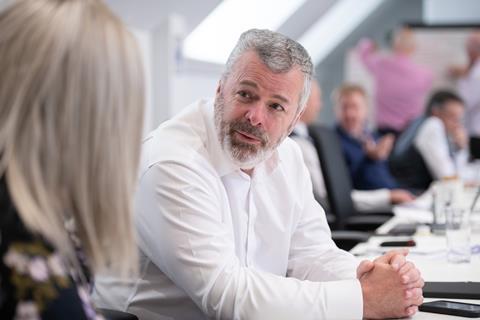Industry stakeholders debated key themes around financing zero-emission trucks at the inaugural Freight Carbon Zero Think Tank recently held at the BVRLA’s HQ. Laura Hailstone reports on the insights and learnings from the event.
With a Green Finance Institute (GFI) report revealing a £50bn-£100bn investment gap exists if the entire UK HGV fleet is to transition to zero-emission trucks (ZETs) by 2050, there is a big question mark over how and who is going to fund the decarbonisation of the sector.
Freight Carbon Zero and the BVRLA brought together a select group of commercial vehicle and road freight stakeholders, earlier this year, for our first Think Tank event to explore what new funding and finance models will be required to assist the industry in its transition.
The purpose of the Freight Carbon Zero Think Tank is to provide a forum for key industry stakeholders to investigate and explore some of the big issues associated with the decarbonisation of the commercial vehicle and road freight sector in a closed forum environment. Everything from price parity and technical uncertainty, to residual values and shared charging infrastructure was debated throughout the day by the Think Tank participants. With representatives from finance and leasing, dealers and manufacturers, consultants and operators, all viewpoints and angles were covered, making for a valuable exchange of ideas and considerations.
Special thanks to all those who attended and for giving Freight Carbon Zero permission to share the highlights and suggested focus areas the Think Tank agreed upon.
-
Technical uncertainty and end of sale dates
The technical uncertainty surrounding ZETs (grid capacity, ZEHID trials, electric v hydrogen debate, rumours of increased grants or falling prices) is causing a delay in making the move to zero emission vehicles, was the first hypothesis the groups discussed.
Chair of the event and Freight Carbon Zero MD Andy Salter, argued the main issue holding back the adoption of ZETs and availability of funding is risk and uncertainty. “Everybody wants to invest in green vehicle technology but there’s still a sense of uncertainty around alternative fuelled vehicles and a lot of misinformation. We need to break down the myths and communicate the certainties around ZETs.”
The Think Tank agreed that a more certain government position on legislation (weight dispensations, operating environment, infrastructure strategy, truck mandate) and costs (grants and incentives, fuel duty, road tax, tariffs) would give operators and infrastructure providers the certainty they need to plan and invest.

Jamie Sands, head of solutions at Welch’s Transport, stresses it is imperative that end of sale dates are adhered to. “The worst thing that we can do is move end of sale dates back by several years as it will just muddy the waters and cause more inertia among operators.”
Suggested actions:
-
End of sale dates to be set in stone - lobby government to confirm the proposed 2035/2040 end of sale dates to provide industry with certainty.
-
Communicate the certainties – trade media across commercial vehicles and business sectors to be engaged in promoting the ZET success stories and highlight the known, proven factors.
-
Call for a a Zero Emission Truck Mandate - along the same lines as the car and van ones.
Implement a Truck Infrastructure Strategy for charging HGVs.
Residual value (RV) risks and guarantees
Financing ZETs involves more than just achieving price parity with diesel vehicles. Recently, finance companies have faced 12-18 months of extreme volatility in the used electric vehicle market, leading to significant losses on RVs.

“Lease and rental companies know they will be buying ZETs at their most expensive price – the only direction [for prices] is down. They are also particularly susceptible to the distortive impacts of sudden discounting (think Tesla), plug-in grant changes or the advent of cheaper new alternatives (think China),” explains Toby Poston, BVRLA’s director of corporate affairs.

To mitigate this, the Think Tank discussed that operators should reconsider the value of truck batteries, which are larger than those in cars and vans and have greater resale or reuse value as energy resources. Tim Campbell, MD of Campbells EV Consultancy, notes: “Old electric bus batteries are already used for energy storage at live events and with renewables,” he said. “A ZET is a mobile generator and a different asset to manage technically and financially. Why not let someone else take the RV risk? This could incentivise leasing.” A view shared by Ian Dennis at Zenobe, a company already heavily involved in this area.

Another solution is to counter the trend towards shorter lease terms, especially in the tractor unit market. Pat Skelly, CEO of Prohire, said: “Zero-emission tractor units need longer leases of five to seven years to be cost-effective. Exploring second-hand leases - a current focus in the electric car market - also makes sense.
Suggested actions:
-
Standardise battery health certificates - greater transparency on the health of the battery, will help to combat the RV risk.
-
Develop a standard way of putting a value on carbon reduction – this could make a big difference in making a business case for investing in ZETs and infrastructure.
-
Change the segmentation and focus on the middle-to light end of the sector
A big area for discussion was the over-focus on decarbonising the heavy end of the truck sector (44 tonnes) which still has a lot more vehicle and technology development to come, plus the necessary charging infrastructure; by comparison, the lighter end should be an easier to decarbonise segment of the market as there is already a wider range of vehicles available with more than adequate range and less reliance on public charging.

“For urban/regional duty cycles in <26t trucks, 80% of journeys can be handled with ZETs now. Even power take-off and refrigeration can be handled,” says Paul Connor, business development director at Specialist Fleet Services. “Fleet operators who have embraced EVs on the LCV market will have a great knowledge transfer into the HGV market which will help accelerate the development and implementation. It’s also a natural evolution from electric LCVs into light HGVs as you’ll already be familiar with the charging and likely to have invested in the infrastructure.”
The Think Tank explored the potential transformation of the industry away from the focus on maximum weight, heavy trucks (44t, six axle combinations) and an assumption that the current diesel-based operating duty cycles have to be replaced on a one-for-one basis. Given the new terms of reference operating battery electric trucks will bring to the table, this could be an opportunity to review traditional distribution models.
However, Welch’s Sands said that “making the total cost of ownership (TCO) work is easier on the larger, heavier trucks” but the group agreed that for the short-term, focusing on the lighter end made more sense as the phase out target for heavies is still a long way off (2040) and there is still too much trade-off in terms of payload, range and cost – which should be resolved as we move closer to the cut-off date.

“There is a feeling that the decarbonisation narrative is dominated by larger, tier one operators which operate a higher proportion of the heaviest trucks and dominate the national/international journeys. They face big challenges and may be more pessimistic about the potential to decarbonise now. Many smaller operators that focus on urban and regional, light and medium truck use cases, are more positive,” explains Chris Welch, MD of Welch’s Transport.
Linked to this, and the related point about infrastructure below, is the misconception that access to Megawatt Charging Systems (1MW and above) is an essential prerequisite for the transition. While it would enable trucks to be charged from empty to full during the 45-minute drivers break, more intelligent means to manage the charge rates of vehicles are available which would remove this dependency.
Suggested actions:
-
Consider a change to the end of sale market segmentation to ease the phasing of the transition:
-
Two-axle rigids: 4.2-19t GVW [Focus the efforts here]
-
Three-axle rigids: 19-26t GVW
-
Four-axle rigids: 32t GVW
-
Articulated combinations: >44t GVW
-
Government review of weights and dimensions has been undertaken – results of that research should now be disseminated around the industry for review.
-
TCO analysis – review whether this should still be the KPI for vehicle operation as it only focuses on the costs of operation and not the gains offered in running ZETs.
-
Infrastructure
Many in the industry are concerned about grid capacity. In the UK, grid capacity is at around 76GW while peak demand is at around 50GW. The problem isn’t having enough electricity, it is having it in the right places, explained Zenobe’s Dennis.
Grid connections are a challenge, but it is not a reason to not do anything. In many cases there are alternative solutions that can help operators get started with one or two electric trucks. Think Tank participants shared examples of operators using their own sites to generate renewable energy, with some operators already looking at installing solar and wind generation capabilities, as well as battery storage. Lots of lessons to be learnt from the bus sector in this area.
Vehicle to grid technology is developing fast and using a truck as a piece of energy can even create a revenue stream. A truck battery could easily power a small office or depot.
At Welch’s Transport, they are intending to give a second-life to batteries from EVs. “If we write the batteries off to zero on the balance sheet, any additional use we get is a bonus,” says Sands. “We’ll use them for grid balancing, solar, and other uses around our site.”
Suggested actions:
-
Gestation period on the delivery of new infrastructure projects is 3-5 years and this needs to be understood by all industry stakeholders to enable better planning.
-
Service level agreements required with Charge Point Operators (CPOs) to ensure they understand the industry needs – this has been an issue in the early stages of some of the zero-emission vehicle trials, possibly addressed now.
-
Overhaul of calculating RVs based on mileage and switch to time-based
The Think Tankers explored the need for a rethink when it comes to how the rental and leasing market calculates the residual values of electric trucks; it is still based on the method used for diesel vehicles which utilises mileage and vehicle age as the main indicators for value.

Amy Carter, EV operations manager at DAF Trucks, says: “If we look at an EV from a mileage perspective, at the end of an eight-year lifespan that vehicle may look like a very attractive prospect with only 30,000 miles on the clock; however, the battery might have been through three charging cycles a day over that period. Calculating RVs based on mileage is no longer fit for purpose when it comes to EVs.”
She believes addressing this will create a huge step change for the way EVs are financed and make the EV space more accessible for small and medium operators.
“The modern truck, no matter what badge is on the front of it, is a digital asset; it is capable of communicating with any kind of electronic or digital base, and it’s also capable of reporting its own operating parameters very accurately. We could use that model not only for efficient operation of the trucks and service but also to calculate more accurately the RV based on battery usage, based on vehicle usage and degradation,” she advises.
The Think Tank agreed that remodelling how RVs are calculated using a time-based or operational hours model will become even more important as the battery starts to be viewed as a stand-alone separate asset from the vehicle, moving into the territory of battery health guarantees and battery health certification.
Suggested actions:
-
Draw up a new RV calculation model based on operational hours for the finance sector to adopt.
-
Run the new model in parallel with the existing RV model to compare and analyse over time.
Top 3 preferred funding options for ZETs
The Green Finance Institute (GFI) has identified 10 demonstrator solutions for financing ZETs and infrastructure (especially beneficial for smaller HGV operators), that it is keen to work with interested parties on to bring to market and mobilise capital at scale.
The Think Tank participants reviewed and then voted on which of the 10 solutions they felt should be explored and taken forward. Here are the top three they chose.
-
Shared Charging Infrastructure Agreement
This was seen as a MUST. Lots of lessons to be learnt from the bus electrification world. Careful attention needs to be paid to who operators partner with to make sure they have different operating cycles. They also need to consider health and safety issues, so that people are on-site to support those sharing the infrastructure.
The Think Tank questioned why aren’t new build industrial sites proactively bringing this kind of agreement into place? There are also challenges with landlords blocking it.
Some interesting innovations were discussed including digital truck stops where operators can reserve access to megawatt chargers.
Welch’s Transport shared that they are planning to build an on-site charging hub at its Cambridge depot, to facilitate a shared user charging infrastructure. “We’re lucky that we have big enough premises and the space to do this at our main HQ, but at some of our other sites we would need to collaborate with local operators to build a charging infrastructure as we just don’t have the space,” explains MD Chris Welch.
-
Component leasing
This is a commercial inevitability and can be done now, the group agreed. It could also make it easier to accept the idea of a ZET having a mid-life refurb where it gets a new battery and the old one is recycled or used for energy storage.
It’s important to identify the way the vehicle will be used, as 100,000 miles of use can see very different battery degradation depending on how the truck is charged (trickle or MCS). Shared RV or lease company will want to understand this as it impacts the RV of the battery.
Similar to the way lease companies have discussions about ‘Fair Wear and Tear’ today, battery health certificates, passports and telematics will have a massive role to play in establishing a trusted, predictable finance and RV model.
OEM business strategies could play a big role in whether this model becomes popular. Will they want to control access to the battery (circular economy) and will they want to make the battery swap-in and out easy?
Ian Dennis, business development director at Zenobe, says: “From Zenobe’s point of view, we see the component aspect of this being really important as being able to take a residual value position on the battery differentiates us from other funders.”
-
RV Guarantee & Small Operator Loan Default
Think Tank participants felt that these two were very similar to each other and resembled the CBILs loans that were made available during Covid, where funders made loans to people that were underwritten by the Government (with a small fee). This would require the government or British Business Bank to get involved.
Finance houses are a lot more pessimistic about EV RVs now, but this could help resolve that issue and reduce the associated risk-cost of EV funding.
Want to take part in our next Think Tank debate or have a topic to suggest? Please contact andy.salter@dvvmediainternational.com


















